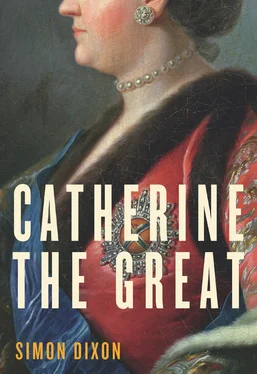As so often, Catherine presented her religious observances as a form of physical endurance from which it was a relief to settle down to work. Amidst the routine letters of congratulation to efficient subordinates, there was time to catch up with artistic purchases ranging from antique gemstones to furniture. On 29 June, she handed over to Grimm the largest single payment of the reign: 100,000 roubles, roughly a third of the total paid to him in Russian coin between 1765 and 1797. Meanwhile, she was as anxious as ever to achieve value for money, warning him not to buy at a public sale: ‘make sure you get the best possible price so that Prince Vyazemsky [in charge of the state budget] doesn’t choke’. 81Much time was spent completing the manifesto on duels, an ultimately ineffective piece of legislation inspired by the Encyclopédie . While confirming her earlier prohibition on duelling, regarded by Catherine as dishonourable, it introduced milder penalties for a crime against the individual. 82When this manifesto was finished, she returned to Blackstone. All her notes on the British jurist had been taken on the journey, along with a copy of her own Instruction, so that she could work on further constitutional reform, which never came to fruition. 83
By early April, even Catherine’s patience was wearing thin. To an absolute monarch who regarded her own travel plans as ‘almost faultless’, it was vexing to be delayed first by the weather and then by Potëmkin. Yet the prince had good reason to prevaricate. Although the prospect of an imperial visit had given renewed urgency to all sorts of dormant provincial projects (the municipal duma at Kharkov was one), not all of them were ready on schedule. Along the route, officials complained about the difficulty of finding sober servants for the empress’s palaces and the impossibility of completing the necessary building work. Pleading for more time on 31 March, the major general in charge of the palace at Kremenchug, where Potëmkin had his headquarters, reported that it was so cold that the pitch was freezing on the roofs. 84Embarrassed by such problems, the prince held Catherine off as long as he could, adamant in his desire to display New Russia in all its glory. But when some of the foreigners in Kiev began to drift away in search of Stanislaw and Joseph II, she determined to leave for the South. 85
On 22 April, the day after publishing her manifesto on duels on her fifty-eighth birthday, Catherine set out at four in the afternoon on board a Roman-style galley, commissioned by Potëmkin, designed by Samuel Bentham and decked out in red and gold. On 16 May, Vice Admiral Peter Ivanovich Pushchin, who had masterminded every one of her cruises since 1767, was invested with the Order of St Alexander Nevsky. 86
* * *
Wending its leisurely way downriver toward the cataracts, the flotilla made frequent stops at picturesque settlements where the empress was greeted by crowds of well-dressed peasants, all carefully stage-managed by Potëmkin and his lieutenants. But it would be wrong to suppose that these ‘Potëmkin villages’—a byword ever since for fraudulent attainments—were cardboard silhouettes, deliberately erected to hoodwink a gullible empress. That was a rumour circulated by the prince’s enemies even before her departure from St Petersburg. 87In fact, Catherine was fully complicit in the theatricality of the cruise, conscious of being the star of an elaborate show. Naturally there were signs of haste in many of the new buildings she saw, but most of her companions chose, like Ségur, to emphasise the scale of the achievements that had been made in a short time. The empress caught the balance nicely by describing Kherson—then a town of 1200 stone buildings and a population of around 50,000, including 5000 convicts—as ‘very fine, for a six-year-old adolescent’. 88It was certainly a different scene from the one that had greeted Bobrinsky and his tutor in 1783, when there had been ‘very few buildings in the town itself’. 89
Catherine reached her principal naval base on the Dnieper estuary on 12 May. There had apparently been no stirring of emotion at her meeting with her former lover, Stanislaw Poniatowski. To the king’s evident chagrin, their interview at Kaniev on 25 April was brief indeed. She not only refused the Polish alliance that Potëmkin had wanted her to make, but determined to press on with her journey without even attending the ball on which Poniatowski had lavished a small fortune. It was more than twenty-five years since they had seen each other. Now, urged on by Potëmkin’s most influential critic, Alexander Vorontsov, she had a more important ally to impress. 90
While the Caucausus reminded Joseph II of the Alps, Catherine and her image-makers invented complex layers of overlapping symbolism which portrayed the Crimean peninsula simultaneously as an Edenic paradise, an exotic Orient and a new Greece, complete with Greek place names and Greek Orthodox bishops, with Catherine cast in the role of Iphigenia in Tauride. 91At the khan’s palace at Bakhchisaray, she heard the imams calling the faithful to prayer five times a day. At Inkerman, overlooking the harbour at Sevastopol, she reviewed the fleet with the emperor. Simferopol and Karazubazar were further exotic destinations on their itinerary. Catherine contributed to the prevailing atmosphere of unreality by collaborating on an ‘Authentic relation of a journey overseas that Sir Léon the Grand Equerry would have undertaken in the opinion of some of his friends’. Written before her departure from St Petersburg, this was a fantasy in which Lev Naryshkin, blown ashore off Constantinople in the sort of preposterous storm that featured widely in eighteenth-century adventure stories, met the Sultan before sailing back to Kronstadt, where he narrowly escaped drowning and had to be rescued by Admiral Greig’s Newfoundland dogs. 92
Catherine herself returned to St Petersburg by land, making the long trek north in the heat of the summer via Poltava, where Potëmkin, who was henceforth allowed to call himself ‘Tavrichesky’ (‘of the Tauride’), staged a re-enactment of Peter the Great’s victory over the Swedes in 1709. Then came Kharkov, Kursk, Orël and Tula, where the empress was too exhausted to attend the nobles’ ball. 93Having arrived at Kolomenskoye late on 23 June, she made her entry into the old capital on the eve of the twenty-fifth anniversary of her accession. Tuesday 29 June, the feast of SS Peter and Paul, was Archbishop Platon’s fiftieth birthday. During the service at the Dormition Cathedral, the empress surprised him by instructing her confessor to address him as ‘metropolitan’, the most senior office in the Russian Orthodox Church. Platon emerged from the altar to bow to her in acknowledgement of his unexpected promotion. 94Next morning, she drove out to Kuskovo to be fêted by Count Nikolay Sheremetev, Count Peter’s son and heir, who had been planning her reception since the previous autumn. ‘The money is flowing like water,’ he told his St Petersburg estate manager on 17 May, announcing that he was ‘building quite a lot’. Apart from the obligatory triumphal arches, the most elaborate project was a new 150-seat theatre, designed by Charles de Wailly, the architect of the French royal opera at Versailles, in conjunction with Louis XVI’s chief theatrical machinist. Catherine sat on a gilded throne in the count’s box for a performance of Grétry’s neoclassical comic opera The Marriage of the Samnites , a celebration of heroic virtue and loyalty to family and state. The heroine was played by Sheremetev’s wife, the former serf Praskovya Kovalyova, who was presented to the empress at the end. Conscious of the effort her host had made, Catherine reassured the expectant Sheremetev that it was the most magnificent performance she had ever seen. 95
Читать дальше












